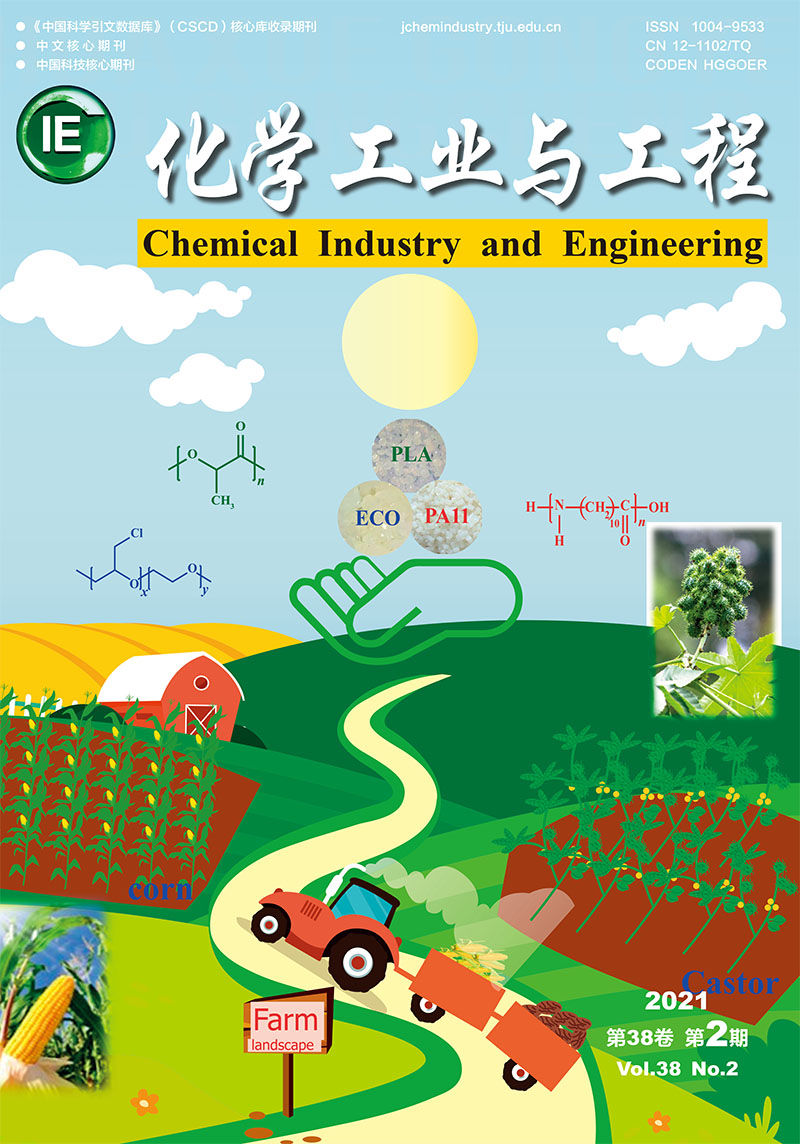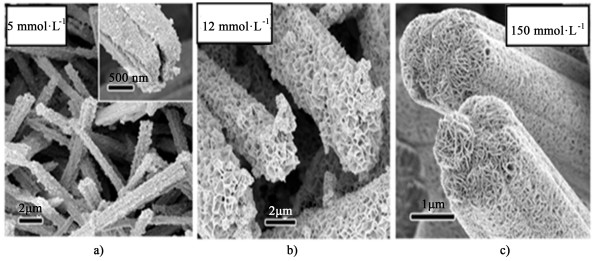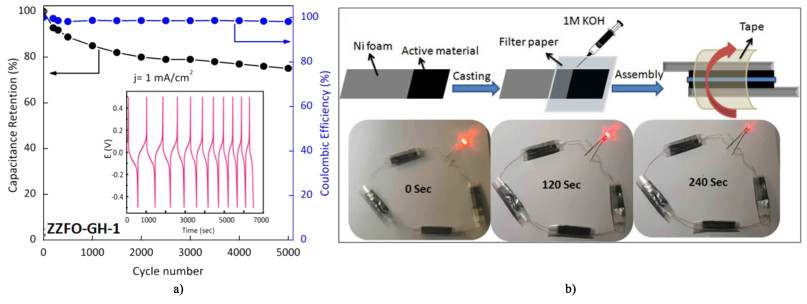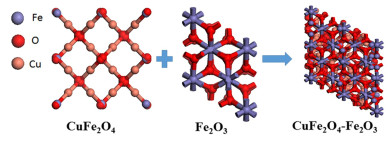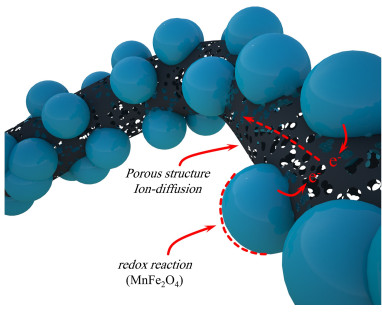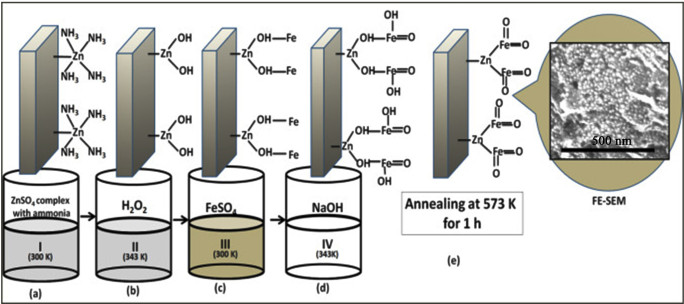2. 上海航天电源技术有限责任公司, 上海 201112
2. Shanghai Aerospace Power Co., Ltd, Shanghai 201112, China
随着工业化进程的不断加快,化石燃料的消耗不断攀升导致雾霾、全球变暖、能源枯竭等问题[1]。鉴于此,研究人员一直在积极寻找新型可再生能源,但是太阳能、风能、潮汐能等新型能源受天气和季节影响有较大的局限性[2]。为了获得持续稳定的能源供给,能源存储和转化装置的开发备受关注。超级电容器,又名电化学电容器,具有充放电速度快、比功率大、循环寿命长、低温性能优异等特点[3]。超级电容器的性能很大程度上取决于电极材料,因此设计和开发先进电极材料迫在眉睫。按电极材料的储能机理分类,超级电容器可分为双电层型和赝电容型,双电层电容器依靠近表面的离子吸脱附,不发生体相扩散;赝电容器一般涉及法拉第过程,电极材料和电解液间发生氧化还原反应[4]。
近年来越来越多的电池型材料应用于超级电容器电极以期获得更高的比能量[5]。很多研究报道将RuO2、Co3O4和NiCo2O4等金属氧化物用于超级电容器电极,但是稀有金属价格高、自然储量有限、废液往往有毒,因此自然界储量较高的铁元素受到了越来越多的关注。铁基氧化物可以在多个价态间(Fe0/Fe2+/Fe3+)发生氧化还原反应,且具有成本低、环境友好的特点[6]。此外,铁基氧化物不仅可以做正极材料,还可以做负极材料,具有较宽的负电位窗口。二元金属氧化物是指含有两种金属元素组成的氧化物,也称为双金属氧化物,当其中一种金属元素是铁元素时则构成铁基二元金属氧化物。和单金属氧化物如Fe2O3、Fe3O4相比,铁基二元金属氧化物能够结合2种金属离子的氧化还原贡献,具有更高的导电性,提供更丰富的电化学活性,从而获得更高的电容性能。下面将从微观结构调控、复合电极制备、一体式电极构建等方面详细综述铁基二元金属氧化物电极材料的研究进展。
1 铁基二元金属氧化物微观结构调控对于具有一定化学成分和晶体结构的材料,其微观结构在较大程度上影响材料的比表面积和界面效应,因此设计有利于离子扩散、电子传导的特定形貌材料可以大幅度提升电化学储能特性[7]。反应体系的动力学参数是常见的形貌调控手段,例如反应时间、温度和pH值等,添加表面活性剂、调整配位剂种类及改变反应溶剂等也是调控的常用方法。
1.1 形貌优化Lin等[8]利用化学刻蚀技术对铁基氧化物的形貌进行优化,使用液态肼刻蚀LiFe5O8块体得到花球状LiFe5O8,在刻蚀45 min后材料的比表面相比未刻蚀前增大112倍,比电容为278 F·g-1,利用同样的刻蚀方法也可以制备得到珊瑚状ZnFe2O4电极材料[9],图 1展示了反应前后的形貌对比。除刻蚀法外,还可以通过二次水热或降低反应液浓度的方式增加表面粗糙度,从而大幅度提高材料的比表面积,从而提高材料的比电容。
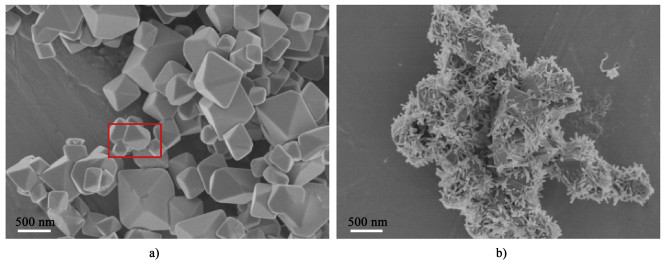
|
| 图 1 刻蚀前后SEM对比图 Fig.1 SEM images before and after etching |
| |
此外,较多研究使用SDS、PVP、PVA、CTAB等表面活性剂作为软模板剂,它们能够吸附在颗粒表面,其产生的静电排斥能够削弱新颗粒的团聚效应,获得片层自组装结构,亦或通过配位效应导致各向异性的生长。分别添加上述4种表面活性剂可以在泡沫镍上生长不同结构的CoFe2O4片层[10]。Fan等[11]通过改变表面活性剂CTAB的用量,采用一步水热及热处理合成了CoFe2O4纳米颗粒、纳米球、中空纳米立方体及实心纳米立方体,其中中空立方体性能最优,容量为1 313.06 F·g-1,但倍率性能有待提高。Gao等[12]通过使用不同沉淀剂制备具有不同微观结构的NiFe2O4,以尿素做沉淀剂得到纳米片状的NiFe2O4,而醋酸钠为沉淀剂时NiFe2O4呈现纳米颗粒,由于纳米片比表面积更大因而具有更高的比电容。不同络合剂的配位速度不同,借助这一特点,Vadiyar等[13]开发了一种在柔性不锈钢网上生长ZnFe2O4的方法,当仅添加MEA(单乙醇胺)时,产物呈现片状阵列,仅添加BGBE(鹰嘴豆提取汁)时基底生长碳颗粒,同时添加2种络合剂可以组装ZnFe2O4/C颗粒附着的三维ZnFe2O4片层。该柔性电极在弯曲、旋转后不影响使用,其作为负极与rGO正极组成的器件比能量可达81 Wh·kg-1。
1.2 尺寸调整材料尺寸变化还可以通过调控粒径和片层厚度得以实现,降低粒径可以充分发挥材料的纳米效应,成倍地增加活性位点。Saravanakumar等[14]采用简单的溶剂热法获得了球形单分散的CuFe2O4纳米粒子,通过提高沉淀剂KOH的浓度能够降低CuFe2O4尺寸至20 nm,进而使得比电容提升20%。研究还发现在制备ZnFe2O4时,pH值升高同样能导致颗粒尺寸显著下降,从而提升电极性能[15]。以上现象可能是由于碱性越强,成核速度越快,导致粒径缩小。Wang等[16]考察了pH值对NiFe2O4合成的影响,发现在pH值为10的条件下,微粒分散性好、粒径合适、电极性能最佳。
Zhu等[17]制备了MnO2片层附着的CoFe2O4纳米管,如图 2所示,MnO2的片层厚度和表面空隙率可由KMnO4浓度调控。PVA-KOH膜与该材料组成的全固态超级电容器工作电压高达1.7 V,比能量为93.6 Wh·kg-1,性能提升较为明显。与此同时,沉淀剂浓度、反应时间、反应温度等一系列实验参数能够调控CuFe2O4纳米球的尺寸和形貌[18],为同类微观结构氧化物的合成提供理论支持。
中空结构功能材料的设计与合成为先进能源存储器件的电极制备提供了崭新思路。中空结构材料具有密度小、比表面积大、活性位点暴露充分、开放型孔道丰富等特点,该特殊结构有利于电极和电解液的有效接触,能够显著增强反应动力学。
在研究中,通常采用模板法合成大小和形貌可控的中空结构,模板法又包括软模板和硬模板,一般来说软模板包括气泡、胶束等,硬模板有硬碳、二氧化硅等,并在后期将硬模板选择性去除[19]。
Zardkhoshoui等[20]设计了一种制备NiFe2O4中空球的方法,以DMF和乙二醇混合液为溶剂,1, 4-苯二甲酸为配体,形成Ni-Fe金属有机框架(MOF),利用热处理过程的非均匀收缩可获得蛋黄壳结构NiFe2O4,最后用石墨烯进行包覆。利用类似方法继续制备NiGa2O4中空球,由rGO-NiGa2O4//rGO-NiFe2O4组成的器件的比能量为118.97 Wh·kg-1。Chu等[21]也构建了NiFe-MOF,发现有机配体的分解导致了中空立方结构的形成,将产物进一步通过2次水热以生长NiCo-LDH和rGO片层包裹的NiFe2O4-NiCo-LDH@rGO中空立方体,该结构提供了超多的活性位点,电极的比能量达750 C·g-1,可以应用于电化学传感器领域。
Li等[22]以碳球为硬模板经陈化反应构建FeMnO3中空球,再与氧化石墨进行复合,中空结构有效改善了离子扩散,并提供离子“蓄水池”。电化学测试表明,该电极具有189 F·g-1的质量比电容。Jhajharia等[23]发现利用碳球和葡萄糖均能合成ZnO/ZnFe2O4蛋黄壳结构,且使用碳球作为模板时制备的材料直径更小,随后将ZnO/ZnFe2O4生长在复合石墨烯的镍网上,图 3展示了该电极优异的循环稳定性和质量比电容。Wang等[24]报道了一种层数可控的CoFe2O4制备方法,通过调整水和乙醇的比例,能够制备出1~4层的中空球结构,其中3层壳的CoFe2O4比表面积最大,电化学性能最佳,该工作创新性的通过空腔体积的调控来进一步优化电极性能。
此外,进一步缩小微粒尺寸,提高材料的均一性和分散性也是中空结构材料的重要研究方向[25]。复杂中空结构的构建通常比较困难,因此基于无模板或自模板的一步合成是未来的发展方向,同时相比于简单中空结构,复杂中空结构如何发挥功能性优势正在受到越来越多的关注。
2 铁基二元金属氧化物复合电极铁基氧化物较差的导电性导致其电极实际容量远低于理论容量。例如Fe3O4电极的理论质量比电容高达2 299 F·g-1[6],但在众多已发表的相关研究中,铁基氧化物电极材料的质量比电容通常小于500 F·g-1,特别是在高质量负载下,离子扩散速率不足,实际质量比电容进一步降低。制备铁基氧化物复合材料能够发挥不同组分之间的协同效应,有效提高电极导电性及电化学性能,解决充放电过程中结构崩塌问题。常见的复合电极有碳材料、氧化物、氢氧化物和导电聚合物等。
2.1 碳材料复合电极碳材料具有比表面积大、化学稳定性好、孔径可调等特点。其中还原氧化石墨烯(rGO)、多壁碳纳米管、活性炭是较常使用的碳材料。碳材料可以作为生长模板,构建三维分级自主装材料。许多研究表明复合碳材料后,铁基氧化物的分散性得以改善,粒子间团聚现象得到缓解并形成导电网络,电极导电性大幅提高。此外,在复合材料制备过程中,添加某些少量碳材料即可显著提高电极性能,比如在含有乌洛托品的NiFe2O4合成液中加入5 mg多壁碳纳米管(CNTs)就可以合成比电容为1 291 F·g-1的超高性能复合电极[26]。
Yang等[27]将源于棉花的活性炭纤维浸泡在含有硝酸锌和硝酸铁的甲醇溶液中,合成的ZnFe2O4纳米颗粒被限制在活性炭纤维上残留的纳米孔中。如图 4所示,此结构避免了材料团聚且提供了连续的电子和离子传输通路。与不添加纤维直接制备的ZnFe2O4相比,比电容和循环稳定性均得到增强。Zhang[28]的工作也体现了限域原理,他们使用微波辅助法合成了由高结晶度ZnFe2O4、大片石墨烯、超小石墨烯构建的双石墨稀网格,该材料丰富的弹性缓冲空间可以适应体积变化,并且拥有较短的Li+扩散路径,电极比容量高达1 257 mAh·g-1。
生物质碳材料来源丰富、绿色环保,体现了物质循环利用的优势,Fu等[29]以蟹壳为原料制备多孔碳材料,实验表明复合材料中CoFe2O4组分的质量百分比为75%时性能最佳,质量比电容为739.4 F·g-1。
Chandel等[30]利用原位共沉淀法制备CuFe2O4/rGO纳米复合材料,在2 A·g-1电流密度下,比电容为797 F·g-1,经过2 000次循环,容量保持率为92%。Mishra等[31]将声化学应用在FeVO4/rGO的合成,在0.5 mA·cm-1电流密度时,比电容为97.5 F·g-1,另外他们通过DFT仿真明确了上述电极材料的杂化结构和电子特性。Chodankar等[32]使用CoFe2O4修饰rGO薄片的构建策略,基于氧化物和rGO很强的化学结合,电极在负电位处具有1 710 F·g-1超高比电容,适合作为不对称超级电容器负极。Tabrizi等[33]利用改良的Hummer法,制备含有锰离子的蠕虫状氧化石墨分散液,后经沉淀反应和还原过程获得MnFe2O4/rGO纳米复合材料,在6 mol/L KOH水溶液中得到271 F·g-1的比电容。在5 000次循环后,电极持久稳定,容量保持率为104%。上述工作旨在利用rGO提高导电性,增大电极材料和电解液的接触面积,改善电极材料在循环过程中的稳定性。引入rGO还可以增加材料表面活性位点并拓宽电位窗口,基于rGO修饰的FeMoO4电容器的电压可达1.8 V[34]。
借助碳材料可交联、易成膜的特点,研究人员制备了可直接作为电极片的碳基复合材料。Zhang等[35]使用凝胶法制备固定着极细NiFe2O4立方体的石墨烯宏观体,经冷冻干燥切割可直接成为电极片,不需要添加黏合剂从而降低内阻,基于该电极组装的全固态柔性器件电压可达1.8 V,比能量为62.5 Wh·kg-1并且在弯曲状态下稳定。Athika等[36]借助湿化学燃烧法,在甘氨酸溶液中合成Ni/NiFe2O4@C复合电极,该电极中Ni与NiFe2O4的协同效应能够增强导电性同时提升氧化还原活性,比能量突破62 Wh·kg-1。Yang等[37]报道了一种被rGO包裹的ZnFe2O4@C核壳材料,利用这种材料构建的ZnFe2O4@C/rGO//AC锂离子电容器最大比能量为174 Wh·kg-1,其增强归因于氧化物和碳材料间的C—O—M键。Geng等[38]采用溶剂为戊醇和环己烷的微乳液法,合成MnFe2O4@C纳米线。原位碳涂层能够提高材料的导电性和孔隙率,MnFe2O4@C电极在0.1 A·g-1时比电容为824 F·g-1,由MnFe2O4@C//AC组成的器件比能量和比功率分别为27 Wh·kg-1和290 W·kg-1。Su等[39]使用DMF作溶剂,以锰铁羰基化合物、氧化石墨为原料,通过简单溶剂热合成MnFe2O4量子点修饰的氮掺杂石墨片层,其结构类似火龙果片,活性物质负载量高,比电容可达905 F·g-1。
由此可见,碳基材料和氧化物之间的协同作用是相互的,碳基材料提供骨架加速离子迁移的同时,氧化物颗粒优化了碳材料的层间距和体密度并且含有碳材料的复合物具有更宽的工作电压,较复合贵金属化合物也具有更低的成本。
2.2 氧化物/氢氧化物复合电极将铁基氧化物和其他具有氧化还原活性的过渡金属氧化物、氢氧化物等进行复合有以下优势。首先,材料结合产生的杂质能带效应可以提高导电性,2种都具有法拉第电容的组分间发生协同效应,可以展现更高的电极性能。另外,铁基氧化物和客体氧化物之间可以形成核壳类异质结构,产生界面效应,为电化学反应提供更多活性位点。
Khan等[40]使用低温共沉积法合成CuFe2O4-Fe2O3复合材料,与同种方法制备的纯CuFe2O4相比,质量比电容提升了16倍。如图 5所示,电极性能的提升主要依靠原子配位结构的改变以及Cu2+和Fe3+离子间的氧化还原耦合效应。
He等[41]构建分级核壳结构的FeCo2O4@NiCo-LDH纳米线,得益于独特的异质结构和界面作用,电极比电容可达2 426 F·g-1,组装的全固态柔性器件具有94.9 Wh·kg-1的高比能量。Wang等[42]成功合成了Co(OH)2@FeCo2O4纳米复合电极,在1 A·g-1时比电容为1 173.4 F·g-1,循环稳定性优异。Chang等[43]在合成NiFe2O4时不额外添加镍盐,以硝酸铁为氧化剂,对硝酸铁的添加量进行优化,最大面积比电容可达1.43 F·cm-2。
如图 6所示,Gopi等[44]先在Ni网表面涂刷导电石墨油墨再通过水热反应构建ZnFe2O4-MnFe2O4/Gink电极,其比电容可达537.96 F·g-1。Zhu[45]和Lin等[46]分别在碳布和泡沫镍表面生长CoFe2O4@MnO2核壳型纳米片层阵列,前者使用3 mol/L KOH水溶液,后者使用PVA-LiCl凝胶电解质,2者比能量均约为22 Wh·kg-1。Liu等[47]利用两步水热法在泡沫Ni基底上构建分级ZnFe2O4@MnO2纳米片阵列生长在ZnFe2O4表面的MnO2呈现蜂巢状,提供了超大的电化学反应面积。制备具有特殊结构的复合材料可以改善电荷转移的效率,多种组分间以化学键的形式有机结合,机械强度高,可以避免额外添加聚合物黏结剂。
导电聚合物主链上存在共轭碱系统,通过掺杂/去掺杂行为储存电荷,其具有导电性好、环保、易合成和低成本等特点。导电聚合物可以优化复合材料的电子结构也可以作为支撑体缓解材料在充放电时发生的体积变化[48]。聚苯胺(PANI)的合成需要低温环境,研究人员一般在冰水浴中合成PANI复合材料,解决纯导电聚合物在多次循环后能量大幅度衰减的问题。Nagaraj等[49]制备了NiFe2O4/PANI复合材料,在高电流密度下冲击后仍能保持良好的循环稳定性,利用该电极制备的全固态柔性器件在折叠和压力下表现出更高的比电容,说明其适用于可弯曲设备。
Lin等[50]采用原位沉积法制备多孔ZnFe2O4/PANI复合电极,氧化物粗糙多孔的特性能够为聚合物提供附着位点,因此获得较大的PANI沉积量。该电极在1 A·g-1电流密度下比电容为328 F·g-1。Ghadimi等[51]借助过硫酸铵和高氯酸制备MnFe2O4纳米颗粒附着的聚苯胺纤维,800 ℃热处理后,材料的氮元素质量分数高达8%,能够显著增强润湿性,此外该结构构建了如图 7所示的电子和离子双重快速传输通路,有利于加快电极的法拉第反应速率。
聚吡咯(PPy)也是使用较多的一类导电聚合物,它含有丰富的亲水性官能团,可以保证电极良好的润湿性,有利于电解质离子扩散和运输。如图 8所示,He等[52]制备了具有核壳结构的CoFe2O4@PPy纳米线,PPy壳的厚度可以通过改变吡咯单体的聚合反应时间进行调控,经过6 h聚合反应的材料性能最佳,具有2 269 F·g-1的超高比电容。Thu等[53]合成rGO/MnFe2O4/PPy复合电极,PPy的质量分数为42.9%时具有最佳的协同效应,在0.5 A·g-1电流密度下质量比电容为147.2 F·g-1。Song等[54]将3, 4-聚乙烯二氧噻吩和聚苯乙烯磺酸喷涂在生长有CoFe2O4纳米颗粒的碳布表面形成具有三明治结构的复合电极,导电聚合物涂层可以有效防止CoFe2O4的脱落,在1 A·g-1电流密度下,该电极的质量比电容为472.5 F·g-1。Sankar等[55]合成CoFe2O4/rGO/PANI复合材料并作为超级电容器负极,CoFe2O4颗粒分散在氧化石墨片层间,缓解了氧化石墨层间堆积的问题,而聚吡咯能够进一步提高复合电极的整体导电性,组装的CoFe2O4/rGO/PANI//βCo(OH)2不对称式器件的面积比电容为4.13 mF·cm-1。
在构筑复合材料的过程中也经常用到元素掺杂手段来调控电极电势、材料润湿性、导电率。例如将复合材料浸于含有尿素和硫代硫酸钠的水热液中反应可获得氮、硫双元素掺杂的CoFe2O4@CNTs,质量比电容可提升近1倍[56]。掺杂元素不限于非金属,当使用质量分数为2%的Zn离子掺杂MgFe2O4时,材料晶体结构和形貌均发生明显变化,阻抗降低,比电容得以提升[57]。
表 1总结了铁基过渡金属氧化物复合材料的测试条件和电化学性能,研究人员试图降低碱液浓度,提高电压区间至0.5 V以上,力求在循环5 000次充放电后仍有90%以上的容量保持率。
| 电极 | 电解液 | 电压区间/V | 比电容 | 稳定性 | Ref. |
| CoFe2O4/CNTs | 2 mol·L-1 KOH | 0~0.50 | 1 204 F·g-1 at 0.5 A·g-1 | 85.6% 1 000 cycles | [66] |
| ZnFe2O4/porous carbon | 2 mol·L-1 KOH | -1.10~0 | 371 F·g-1 at 5.0 mV s-1 | 81.3% 20 000cycles | [35] |
| CoFe2O4/C | 2 mol·L-1 KOH | 0~0.40 | 600 F·g-1 at 1.0 A·g-1 | 80.8% 1 000cycles | [74] |
| CoFeO2O4/rGO/PANI | 1 mol·L-1 KOH | -0.17~0.93 | 239 F·g-1 at 3.0 mA | 87.0% 1 000cycles | [62] |
| CoFe2O4@PPy | alkaline | 0~0.50 | 2 269 F·g-1 at 1.0 A·g-1 | 90.2% 5 000cycles | [52] |
| CoFe2O4@MnO2 | 3 mol·L-1 KOH | 0~0.45 | 3.08 F·cm-1 at 2.0 mA·cm-2 | 99.1% 5 000cycles | [67] |
| MnFe2O4/graphene | 1 mol·L-1 H2SO4 | 0~0.80 | 300 F·g-1 at 0.3 A·g-1 | 105.0% 5 000cycles | [53] |
| MnFe2O4/N-doped-C | 1 mol·L-1 H2SO4 | -0.20~1.00 | 387 F·g-1 at 1.0 A·g-1 | 97.0% 10 000cycles | [51] |
| CuFe2O4-Fe2O3 | 1 mol·L-1 H2SO4 | 0~0.50 | 638.24 F·g-1 at 2.0 A·g-1 | ~95.0% 2 000cycles | [40] |
| Holey C@ZnFe2O4 | 6 mol·L-1 KOH | -1.00~0 | 1 452 F·g-1 at 1.0 A·g-1 | 96.0% 50 000cycles | [68] |
| ZnFe2O/ZnO/rGO | 1 mol·L-1 KOH | 0~0.70 | 3 500 F·g-1 at 0.5 A·g-1 | 80.0% 5 000cycles | [23] |
| ZnFe2O4/g-C3N4 | 6 mol·L-1 KOH | 0~0.60 | 103 F·g-1 at 10.0 A·g-1 | 94.0% 500cycles | [69] |
| NiFe2O4@MoS2 | 1 mol·L-1 KOH | 0~0.45 | 506 F·g-1 at 1.0 A·g-1 | 90.7% 3 000cycles | [70] |
| NiFe2O4@CoFe2O4 | 3 mol·L-1 KOH | 0~0.40 | 480 F·g-1 at 1.0 A·g-1 | 87.0% 2 000cycles | [71] |
| Co3O4@FeCo2O4 | 2 mol·L-1 KOH | 0~0.50 | 1 680 F·g-1 at 1.0 A·g-1 | 91.2% 2 000cycles | [72] |
| FeWO4/g-C3N4 | 2 mol·L-1 KOH | 0~0.55 | 357 F·g-1 at 5.0 mV s-1 | 80% 1 000cycles | [73] |
| Fe-Ni-Co ternary oxide | 1 mol·L-1 KOH | 0~0.45 | 867 F·g-1 at 1.0 A·g-1 | 92.3% 10 000 cycles | [75] |
构建具有导电基底的一体式电极能够去除黏结剂、形成分级结构,并有利于柔性器件的组装。常用的基底包括泡沫镍、不锈钢网、碳布等。柔性电极的制备及与固态电解质的结合,能够获得具有可拉伸、可穿戴、透明等功能的超级电容器。在水热溶剂中添加尿素和氟化铵能够在金属基底表面生长片层阵列。Mohamed等[58]按照此种方案构建FeCo2O4/Ni一体式电极,在1 mV·s-1扫速下获得433 F·g-1的比电容,将这种材料用于锂离子电池阳极也获得了较高容量。
Zhang等[59]采用两步水热与煅烧处理相结合的方法,制备了NiFe2O4@MnO2纳米片阵列,电流密度为2 mA·cm-2时,复合电极的比电容为1 391 F·g-1,由NiFe2O4@MnO2//AC组成的器件的比能量为45.2 Wh·kg-1。Javed等[60]报道了使用低温水热法在碳纺布材料上生长分级介孔NiFe2O4纳米锥,纳米锥之间的开放空间便于电解质扩散。以LiCl为电解液,能够缓解碱性溶液对设备的腐蚀以及爬碱现象,该电极组装对称式电容器的比能量为54.9 Wh·kg-1,3个串联的器件可以点亮4枚额定电压为2 V的LED小灯2 min,体现了实际应用的潜力。如图 9所示,Raut等[61]使用连续离子层吸附法(SILAR),在不使用表面活性剂或模板的情况下,将不锈钢网依次浸泡在两种阳离子和阴离子前驱溶液中,经过热处理即可获得ZnFe2O4薄膜。在1 mol·L-1 KOH溶液中,电极比电容为471 F·g-1,采用PVA-LiClO4凝胶电解质组成的对称式超级电容器的比能量为53.22 Wh·kg-1。
柔性电容器的关键是制备具有足够机械强度的柔性电极,如图 10所示,Cai等[62]通过简单的溶剂热法将MnFe2O4附着在石墨烯薄片上,再将分散液滴在作为集流体的石墨片层上烘干,以PVA-H2SO4为电解质,电极厚度仅227 μm。Zhao等[63]在碳砂芯表面生长有序大孔蜂窝状NiFe2O4,结构稳定且便于离子传输,将2根涂覆PVA-KOH凝胶的砂线缠绕即完成纤维器件的组装,比电容可达247 mF·cm-1,该器件可作为可穿戴设备的储能单元。
不难发现,生长于基底表面的针状、片层状、管状阵列常作为前驱体,通过对其进行表面成分调控、次级结构优化可形成稳定的三维网络从而显著改善离子扩散、降低接触电阻[64-65]。
4 总结与展望作为超级电容器的电极材料,铁基二元金属氧化物已得到广泛的研究。微观结构调控能够提高材料的比表面积,而复合电极的构建能够显著改善电极导电性。通过调配电解质类型和优化正负电极匹配能够提高器件的工作电压和性能,但在以下方面仍面临困难和挑战:1)铁基二元金属氧化物的电子结构和晶体结构调控对于电极电势、稳定性和导电性的影响机理方面的研究仍有欠缺;可以借助计算和模拟,深入了解界面现象、晶体氧空位、电荷传导对电极性能的作用机制,自上而下、有据可循地开展材料设计;2)铁基过渡金属氧化物的低电导率是影响电极性能的关键点之一,对此今后可采取部分硫化或硒化的方法改善电子结构进而提高电导率;3)铁基氧化物的电化学窗口较低,通过调整金属元素的比例可实现对电极电位的有效调控,提升晶体的本征电化学活性;4)近来NbFe2O4、SrFe2O4等铁基氧化物逐渐应用在锂离子电池等储能器件,此类电极用于超级电容器领域的研究能够成为新机遇。
此外,随着便携式移动电子设备、可穿戴电子产品领域的技术革新,超级电容器的相关创新研究将呈井喷式增长。超级电容器向柔性、微型化、纤维化等方向的发展会成为必然趋势,这也将带动柔性电极材料和柔性全固态电解质的同步发展。
| [1] |
Chien H, Cheng W, Wang Y, et al. Ultrahigh specific capacitances for supercapacitors achieved by nickel cobaltite/carbon aerogel composites[J]. Advanced Functional Materials, 2012, 22(23): 5038-5043. DOI:10.1002/adfm.201201176 |
| [2] |
Tarascon J M, Armand M. Issues and challenges facing rechargeable lithium batteries[J]. Nature, 2001, 414(6861): 359-367. DOI:10.1038/35104644 |
| [3] |
Dunn B, Kamath H, Tarascon J M. Electrical energy storage for the grid: A battery of choices[J]. Science, 2011, 334(6058): 928-935. DOI:10.1126/science.1212741 |
| [4] |
Lu X, Yu M, Wang G, et al. Flexible solid-state supercapacitors: Design, fabrication and applications[J]. Energy and Environmental Science, 2014, 7(7): 2160-2181. DOI:10.1039/c4ee00960f |
| [5] |
Zuo W, Li R, Zhou C, et al. Battery-Supercapacitor hybrid devices: Recent progress and future prospects[J]. Advanced Science, 2017. DOI:10.1002/advs.201600539 |
| [6] |
Nithya V D, Sabari Arul N. Progress and development of Fe3O4 electrodes for supercapacitors[J]. Journal of Materials Chemistry, 2016, 4(28): 10767-10778. DOI:10.1039/C6TA02582J |
| [7] |
Chen K, Xue D. Materials chemistry toward electrochemical energy storage[J]. Journal of Materials Chemistry, 2016, 4(20): 7522-7537. DOI:10.1039/C6TA01527A |
| [8] |
Lin Y, Dong J, Dai J, et al. Facile synthesis of flowerlike LiFe5O8 microspheres for electrochemical supercapacitors[J]. Inorganic Chemistry, 2017, 56(24): 14960-14967. DOI:10.1021/acs.inorgchem.7b02257 |
| [9] |
Lin Y, Zhang J, Li M, et al. An excellent strategy for synthesis of coral-like ZnFe2O4 particles for capacitive pseudocapacitors[J]. Journal of Alloys and Compounds, 2017, 726: 154-163. DOI:10.1016/j.jallcom.2017.07.328 |
| [10] |
Gao L, Han E, He Y, et al. Effect of different templating agents on cobalt ferrite (CoFe2O4) nanomaterials for high-performance supercapacitor[J]. Ionics, 2020, 1-12. |
| [11] |
Fan S, Wang W, Ke H, et al. Facile synthesis of morphology controllable CoFe2O4 particles as high-performance electrode materials[J]. Particle & Particle Systems Characterization, 2018. DOI:10.1002/ppsc.201800223 |
| [12] |
Gao X, Wang W, Bi J, et al. Morphology-Controllable preparation of NiFe2O4 as high performance electrode material for supercapacitor[J]. Electrochimica Acta, 2019, 296: 181-189. DOI:10.1016/j.electacta.2018.11.054 |
| [13] |
Vadiyar M M, Kolekar S S, Chang J, et al. Anchoring ultrafine ZnFe2O4/C nanoparticles on 3D ZnFe2O4 nanoflakes for boosting cycle stability and energy density of flexible asymmetric supercapacitor[J]. ACS Applied Materials & Interfaces, 2017, 9(31): 26016-26028. |
| [14] |
Saravanakumar B, Ramachandran S P, Ravi G, et al. Electrochemical performances of monodispersed spherical CuFe2O4 nanoparticles for pseudocapacitive applications[J]. Vacuum, 2019. DOI:10.1016/j.vacuum.2019.108798 |
| [15] |
Shanmugavani A, Kalai Selvan R. Synthesis of ZnFe2O4 nanoparticles and their asymmetric configuration with Ni(OH)2 for a pseudocapacitor[J]. RSC Advances, 2014, 4(51): 27022-27029. DOI:10.1039/c4ra01793e |
| [16] |
Wang Z, Zhang X, Li Y, et al. Synthesis of graphene-NiFe2O4 nanocomposites and their electrochemical capacitive behavior[J]. Journal of Materials Chemistry, 2013, 1(21): 6393-6399. DOI:10.1039/c3ta10433h |
| [17] |
Zhu F, Liu Y, Yan M, et al. Construction of hierarchical FeCo2O4@MnO2 core-shell nanostructures on carbon fibers for high-performance asymmetric supercapacitor[J]. Journal of Colloid and Interface Science, 2018, 512: 419-427. DOI:10.1016/j.jcis.2017.09.093 |
| [18] |
Zhu M, Meng D, Wang C, et al. Facile fabrication of hierarchically porous CuFe2O4 nanospheres with enhanced capacitance property[J]. ACS Applied Materials & Interfaces, 2013, 5(13): 6030-6037. |
| [19] |
Yu L, Hu H, Wu H, et al. Complex hollow nanostructures: Synthesis and energy-related applications[J]. Advanced Materials, 2017. DOI:10.1002/adma.201604563 |
| [20] |
Zardkhoshoui A M, Davarani S S H. Formation of graphene-wrapped multi-shelled NiGa2O4 hollow spheres and graphene-wrapped yolk-shell NiFe2O4 hollow spheres derived from metal-organic frameworks for high-performance hybrid supercapacitors[J]. Nanoscale, 2020, 12(3): 1643-1656. DOI:10.1039/C9NR09108D |
| [21] |
Chu D, Li F, Song X, et al. A novel dual-tasking hollow cube NiFe2O4-NiCo-LDH@rGO hierarchical material for high preformance supercapacitor and glucose sensor[J]. Journal of Colloid and Interface Science, 2020, 568: 130-138. DOI:10.1016/j.jcis.2020.02.012 |
| [22] |
Li M, Xu W, Wang W, et al. Facile synthesis of specific FeMnO3 hollow sphere/graphene composites and their superior electrochemical energy storage performances for supercapacitor[J]. Journal of Power Sources, 2014, 248: 465-473. DOI:10.1016/j.jpowsour.2013.09.075 |
| [23] |
Jhajharia S K, Manappadan Z, Selvaraj K. Exploring battery-type ZnO/ZnFe2O4 spheres-3D graphene electrodes for supercapacitor applications: Advantage of yolk-shell over solid structures[J]. ChemElectroChem, 2019, 6(23): 5819-5828. DOI:10.1002/celc.201901269 |
| [24] |
Wang Y, Su D, Ung A T, et al. Hollow CoFe2O4 nanospheres as a high capacity anode material for lithium ion batteries[J]. Nanotechnology, 2012. DOI:10.1088/0957-4484/23/5/055402 |
| [25] |
Ren P, Wang Z, Liu B, et al. Highly dispersible hollow nanospheres organized by ultra-small ZnFe2O4 subunits with enhanced lithium storage properties[J]. Journal of Alloys and Compounds, 2020. DOI:10.1016/j.jallcom.2019.152014 |
| [26] |
Kumar N, Kumar A, Huang G M, et al. Facile synthesis of mesoporous NiFe2O4/CNTS nanocomposite cathode material for high performance asymmetric pseudocapacitors[J]. Applied Surface Science, 2018, 433: 1100-1112. DOI:10.1016/j.apsusc.2017.10.095 |
| [27] |
Yang S, Han Z, Zheng F, et al. ZnFe2O4 nanoparticles-cotton derived hierarchical porous active carbon fibers for high rate-capability supercapacitor electrodes[J]. Carbon, 2018, 134: 15-21. DOI:10.1016/j.carbon.2018.03.071 |
| [28] |
Zhang L, Wei T, Yue J, et al. Ultrasmall and highly crystallized ZnFe2O4 nanoparticles within double graphene networks for super-long life lithium-ion batteries[J]. Journal of Materials Chemistry A, 2017, 5(22): 11188-11196. DOI:10.1039/C7TA02726E |
| [29] |
Fu M, Chen W, Ding J, et al. Biomass waste derived multi-hierarchical porous carbon combined with CoFe2O4 as advanced electrode materials for supercapacitors[J]. Journal of Alloys and Compounds, 2019, 782: 952-960. DOI:10.1016/j.jallcom.2018.12.244 |
| [30] |
Chandel M, Moitra D, Makkar P, et al. Synthesis of multifunctional CuFe2O4-reduced graphene oxide nanocomposite: An efficient magnetically separable catalyst as well as high performance supercapacitor and first-principles calculations of its electronic structures[J]. RSC Advances, 2018, 8(49): 27725-27739. DOI:10.1039/C8RA05393F |
| [31] |
Mishra A, Bera G, Mal P, et al. Comparative electrochemical analysis of rGO-FeVO4 nanocomposite and FeVO4 for supercapacitor application[J]. Applied Surface Science, 2019, 488: 221-227. DOI:10.1016/j.apsusc.2019.05.259 |
| [32] |
Chodankar N R, Dubal D P, Ji S H, et al. Highly efficient and stable negative electrode for asymmetric supercapacitors based on graphene/FeCo2O4 nanocomposite hybrid material[J]. Electrochimica Acta, 2019, 295: 195-203. DOI:10.1016/j.electacta.2018.10.125 |
| [33] |
Tabrizi A G, Arsalani N, Mohammadi A, et al. Facile synthesis of a MnFe2O4/rGO nanocomposite for an ultra-stable symmetric supercapacitor[J]. New Journal of Chemistry, 2017, 41(12): 4974-4984. DOI:10.1039/C6NJ04093D |
| [34] |
Ranjith K S, Raju G S R, Chodankar N R, et al. Electroactive ultra-thin rGO-enriched FeMoO4 nanotubes and MnO2 nanorods as electrodes for high-performance all-solid-state asymmetric supercapacitors[J]. Nanomaterials, 2020. DOI:10.3390/nano10020289 |
| [35] |
Zhang X, Zhu M, Ouyang T, et al. NiFe2O4 nanocubes anchored on reduced graphene oxide cryogel to achieve a 1.8 eV flexible solid-state symmetric supercapacitor[J]. Chemical Engineering Journal, 2019, 360: 171-179. DOI:10.1016/j.cej.2018.11.206 |
| [36] |
Athika M, Prasath A, Sharma A S, et al. Ni/NiFe2O4@carbon nanocomposite involving synergistic effect for high-energy density and high-power density supercapattery[J]. Materials Research Express, 2019. DOI:10.1088/2053-1591/ab2c59 |
| [37] |
Yang C, Sun M, Zhang L, et al. ZnFe2O4@Carbon core-shell nanoparticles encapsulated in reduced graphene oxide for high-performance Li-ion hybrid supercapacitors[J]. ACS Applied Materials & Interfaces, 2019, 11(16): 14713-14721. |
| [38] |
Geng L, Yan F, Dong C, et al. Design and regulation of novel MnFe2O4@C nanowires as high performance electrode for supercapacitor[J]. Nanomaterials, 2019. DOI:10.3390/nano9050777 |
| [39] |
Su L, Lei S, Liu L, et al. Sprinkling MnFe2O4 quantum dots on nitrogen-doped graphene sheets: The formation mechanism and application for high-performance supercapacitor electrodes[J]. Journal of Materials Chemistry, 2018, 6(21): 9997-10007. DOI:10.1039/C8TA02982B |
| [40] |
Khan R, Habib M, Gondal M A, et al. Facile synthesis of CuFe2O4-Fe2O3 composite for high-performance supercapacitor electrode applications[J]. Materials Research Express, 2017. DOI:10.1088/2053-1591/aa8dc4 |
| [41] |
He X, Li R, Liu J, et al. Hierarchical FeCo2O4@NiCo layered double hydroxide core/shell nanowires for high performance flexible all-solid-state asymmetric supercapacitors[J]. Chemical Engineering Journal, 2018, 334: 1573-1583. DOI:10.1016/j.cej.2017.11.089 |
| [42] |
Wang Z, Hong P, Peng S, et al. Co(OH)2@FeCo2O4 as electrode material for high performance faradaic supercapacitor application[J]. Electrochimica Acta, 2019, 299: 312-319. DOI:10.1016/j.electacta.2019.01.017 |
| [43] |
Chang Z, Li T, Li G, et al. One-Pot in situ synthesis of Ni(OH)2: NiFe2O4 nanosheet arrays on nickel foam as binder-free electrodes for supercapacitors[J]. Journal of Materials Science: Materials in Electronics, 2019, 30(1): 600-608. DOI:10.1007/s10854-018-0326-0 |
| [44] |
Gopi C V M, Vinodh R, Sambasivam S, et al. Co9S8-Ni3S2 CuMn2O4-NiMn2O4 and MnFe2O4-ZnFe2O4/graphene as binder-free cathode and anode materials for high energy density supercapacitors[J]. Chemical Engineering Journal, 2020. DOI:10.1016/j.cej.2019.122640 |
| [45] |
Lin L, Tang S, Zhao S, et al. Hierarchical three-dimensional FeCo2O4@MnO2 core-shell nanosheet arrays on nickel foam for high-performance supercapacitor[J]. Electrochimica Acta, 2017. DOI:10.1016/j.electacta.2017.01.022 |
| [46] |
Zhu F, Liu Y, Yan M, et al. Construction of hierarchical FeCo2O4@MnO2 core-shell nanostructures on carbon fibers for high-performance asymmetric supercapacitor[J]. Journal of Colloid and Interface Science, 2018, 512: 419-427. DOI:10.1016/j.jcis.2017.09.093 |
| [47] |
Liu C, Peng T, Wang C, et al. Three-Dimensional ZnFe2O4@MnO2 hierarchical core/shell nanosheet arrays as high-performance battery-type electrode materials[J]. Journal of Alloys and Compounds, 2017, 720: 86-94. DOI:10.1016/j.jallcom.2017.05.145 |
| [48] |
Mohd A M A A, Azman N H N, Kulandaivalu S, et al. Review of the use of transition-metal-oxide and conducting polymer-based fibres for high-performance supercapacitors[J]. Materials & Design, 2020. DOI:10.1016/j.matdes.2019.108199 |
| [49] |
Nagaraj R, Aruchamy K, Halanur M M, et al. Boosting the electrochemical performance of polyaniline based all-solid-state flexible supercapacitor using NiFe2O4 as adjuvant[J]. Journal of Electroanalytical Chemistry, 2019. DOI:10.1016/j.jelechem.2019.113620 |
| [50] |
Lin Y, Wang J, Liu A, et al. Deposition of polyaniline on porous ZnFe2O4 as electrode for enhanced performance supercapacitor[J]. Journal of Materials Science: Materials in Electronics, 2018, 29(19): 16369-16377. DOI:10.1007/s10854-018-9728-2 |
| [51] |
Saleh G L, Arsalani N, Tabrizi A G, et al. Novel nanocomposite of MnFe2O4 and nitrogen-doped carbon from polyaniline carbonization as electrode material for symmetric ultra-stable supercapacitor[J]. Electrochimica Acta, 2018, 282: 116-127. DOI:10.1016/j.electacta.2018.05.160 |
| [52] |
He X, Zhao Y, Chen R, et al. Hierarchical FeCo2O4@polypyrrole core/shell nanowires on carbon cloth for high-performance flexible all-solid-state asymmetric supercapacitors[J]. ACS Sustainable Chemistry & Engineering, 2018, 6(11): 14945-14954. |
| [53] |
Thu T V, van Nguyen T, Le X D, et al. Graphene-MnFe2O4-polypyrrole ternary hybrids with synergistic effect for supercapacitor electrode[J]. Electrochimica Acta, 2019, 314: 151-160. DOI:10.1016/j.electacta.2019.05.042 |
| [54] |
Song K, Wang X, Wang J, et al. Bifunctional conducting polymer coated CoFe2O4 core-shell nanolayer on carbon fiber cloth for 2.0 V wearable aqueous supercapacitors[J]. Chemistry Select, 2019, 4(5): 1685-1695. |
| [55] |
Vijaya S K, Kalai S R. Fabrication of flexible fiber supercapacitor using covalently grafted CoFe2O4/reduced graphene oxide/polyaniline and its electrochemical performances[J]. Electrochimica Acta, 2016, 213: 469-481. DOI:10.1016/j.electacta.2016.07.056 |
| [56] |
Li Y, Song C, Chen J, et al. Sulfur and nitrogen Co-doped activated CoFe2O4@C nanotubes as an efficient material for supercapacitor applications[J]. Carbon, 2020, 162: 124-135. DOI:10.1016/j.carbon.2020.02.050 |
| [57] |
Uke S J, Mardikar S P, Bambole D R, et al. Sol-Gel citrate synthesized Zn doped MgFe2O4 nanocrystals: A promising supercapacitor electrode material[EB/OL]. 2020
|
| [58] |
Mohamed S G, Chen C, Chen C, et al. High-Performance lithium-ion battery and symmetric supercapacitors based on FeCo2O4 nanoflakes electrodes[J]. ACS Applied Materials & Interfaces, 2014, 6(24): 22701-22708. |
| [59] |
Zhang X, Zhang, Z, Sun S, et al. Hierarchical 3D NiFe2O4@MnO2 core-shell nanosheet arrays on Ni foam for high-performance asymmetric supercapacitors[J]. Dalton transactions, 2018, 47(7): 2266-2273. DOI:10.1039/C7DT04127F |
| [60] |
Javed M S, Zhang C, Chen L, et al. Hierarchical mesoporous NiFe2O4 nanocone forest directly growing on carbon textile for high performance flexible supercapacitors[J]. Journal of Materials Chemistry, 2016, 4(22): 8851-8859. DOI:10.1039/C6TA01893A |
| [61] |
Raut S S, Sankapal B R. First report on synthesis of ZnFe2O4 thin film using successive ionic layer adsorption and reaction: Approach towards solid-state symmetric supercapacitor device[J]. Electrochimica Acta, 2016, 198: 203-211. DOI:10.1016/j.electacta.2016.03.059 |
| [62] |
Cai W, Lai T, Dai W, et al. A facile approach to fabricate flexible all-solid-state supercapacitors based on MnFe2O4/graphene hybrids[J]. Journal of Power Sources, 2014, 255: 170-178. DOI:10.1016/j.jpowsour.2014.01.027 |
| [63] |
Zhao P, Ye X, Zhu Y, et al. Three-Dimensional ordered macroporous NiFe2O4 coated carbon yarn for knittable fibriform supercapacitor[J]. Electrochimica Acta, 2018, 281: 717-724. DOI:10.1016/j.electacta.2018.05.166 |
| [64] |
Song K, Chen X, Yang R, et al. Novel hierarchical CoFe2Se4@CoFe2O4 and CoFe2S4@CoFe2O4 core-shell nanoboxes electrode for high-performance electrochemical energy storage[J]. Chemical Engineering Journal, 2020. DOI:10.1016/j.cej.2020.124175 |
| [65] |
Song K, Wang X, Li J, et al. 3D hierarchical CoFe2O4/CoOOH nanowire arrays on Ni-sponge for high-performance flexible supercapacitors[J]. Electrochimica Acta, 2020. DOI:10.1016/j.electacta.2020.135892 |
| [66] |
Yue L, Zhang S, Zhao H, et al. One-Pot synthesis CoFe2O4/CNTS composite for asymmetric supercapacitor electrode[J]. Solid State Ionics, 2019, 329: 15-24. DOI:10.1016/j.ssi.2018.11.006 |
| [67] |
Gao H, Xiang J, Cao Y. Controlled synthesis of MnO2 nanosheets vertically covered FeCo2O4 nanoflakes as a binder-free electrode for a high-power and durable asymmetric supercapacitor[J]. Nanotechnology, 2017. DOI:10.1088/1361-6528/aa6f89 |
| [68] |
Vadiyar M M, Bandgar S B, Kolekar S S, et al. Holey C@ZnFe2O4 nanoflakes by carbon soot layer blasting approach for high performance supercapacitors[J]. ACS Applied Energy Materials, 2019, 2(9): 6693-6704. DOI:10.1021/acsaem.9b01195 |
| [69] |
Palanivel B, Mudisoodum P S D, Maiyalagan T, et al. Rational design of ZnFe2O4/g-C3N4 nanocomposite for enhanced photo-Fenton reaction and supercapacitor performance[J]. Applied Surface Science, 2019. DOI:10.1016/j.apsusc.2019.143807 |
| [70] |
Zhao Y, Xu L, Yan J, et al. Facile preparation of NiFe2O4/MoS2 composite material with synergistic effect for high performance supercapacitor[J]. Journal of Alloys and Compounds, 2017, 726: 608-617. DOI:10.1016/j.jallcom.2017.07.327 |
| [71] |
Wang Q, Gao H, Qin X, et al. Fabrication of NiFe2O4@CoFe2O4 core-shell nanofibers for high-performance supercapacitors[J]. Materials Research Express, 2020. DOI:10.1088/2053-1591/ab61ba |
| [72] |
Wu Q, Zhao Y, Yu J, et al. Controlled growth of hierarchical FeCo2O4 ultrathin nanosheets and Co3O4 nanowires on nickle foam for supercapacitors[J]. International Journal of Hydrogen Energy, 2019, 44(60): 31780-31789. DOI:10.1016/j.ijhydene.2019.10.119 |
| [73] |
Ojha D P, Karki H P, Song J H, et al. Decoration of g-C3N4 with hydrothermally synthesized FeWO4 nanorods as the high-performance supercapacitors[J]. Chemical Physics Letters, 2018, 712: 83-88. DOI:10.1016/j.cplett.2018.09.070 |
| [74] |
Zhao Y, Xu Y, Zeng J, et al. Low-Crystalline mesoporous CoFe2O4/C composite with oxygen vacancies for high energy density asymmetric supercapacitors[J]. RSC Advances, 2017, 7(87): 55513-55522. DOI:10.1039/C7RA11741H |
| [75] |
Sahoo S, Nguyen T T, Shim J J. Mesoporous Fe-Ni-Co ternary oxide nanoflake arrays on Ni foam for high-performance supercapacitor applications[J]. Journal of Industrial and Engineering Chemistry, 2018, 63: 181-190. DOI:10.1016/j.jiec.2018.02.014 |
 2021, Vol. 38
2021, Vol. 38